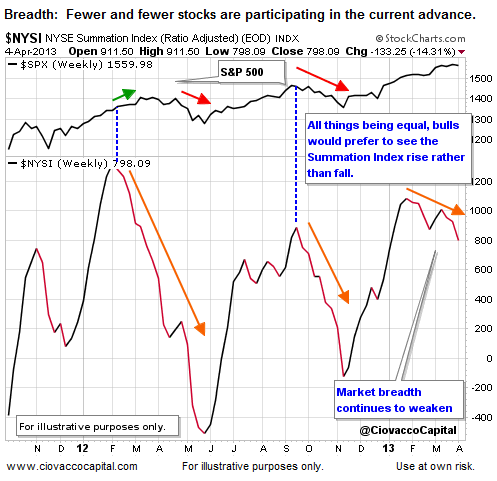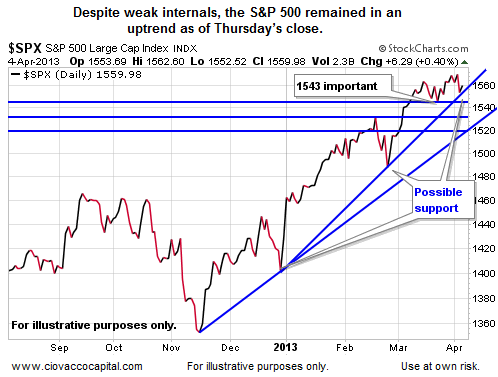Economic Data Disappoints
Earlier this week, we noted numerous concerns piling up in the stock and bond markets, such as leadership being provided by historically defensive sectors. The “read” by the markets may have been correct as recent economic data has fallen into the “concerning” category. Monday’s ISM manufacturing report came in well below expectations. The ADP Employment report released Wednesday also failed to meet expectations. Friday morning, the news from Europe continued the negative trend, including the reemergence of “bird flu” concerns. From Bloomberg:
European stocks fell for a third day and bond yields from France to Austria slid to records as retail sales declined. U.S. equity-index futures dropped after analysts cut estimates for growth in monthly payrolls data set for today. Airline shares slid on concern an outbreak of bird flu in China will hurt travel demand. Retail sales in the euro area fell 0.3 percent in February from the previous month, a report showed today. Analysts cut estimates for U.S. payrolls growth last month after reports this week showed companies added fewer workers than forecast and jobless claims rose more than estimated.
Bulls Need Report To Improve Tone
Prior to reviewing the state of the markets as of Thursday’s close, it is important to note if any economic report can “flip the charts”, it is the widely-anticipated monthly labor report, which is on tap for Friday morning.
Two Outcomes – Not Complex
One of two things has to happen in the coming days and weeks:
- Stocks decline to come into alignment with all the disconnects behind the scenes, or
- Stocks continue to rise and the disconnects are cleared.
What are the “disconnects”? Answer: All the “yellow flag” charts covered in this March 29 video. Have the yellow flags produced any results this week? So far, yes; the S&P 500 dropped 9 points between Monday’s open and Thursday’s close. The outcome with the lowest probability is stocks continue to rise with the disconnects remaining in place; that is just not how markets work – either 1 or 2 above needs to occur.
Fewer And Fewer Stocks Participating
One example of a “yellow flag” or “disconnect” is market breadth. Market breadth refers to the number of stocks participating in an advance. Healthy markets have broad participation. As an advance tires, fewer and fewer stocks participate in the gains, which is exactly what we have now. When market breadth is strengthening, the Summation Index (below) tends to rise. It is currently falling and is now in a downtrend (lower highs & lower lows).

Bird Flu Back On Radar
Six people have reportedly died from the H7N9 “bird flu” virus in east China. China has so far confirmed 14 H7N9 cases, according to the Xinhua report, including six in Shanghai, four in Jiangsu, three in Zhejiang and one in Anhui. Obviously, economic concerns arise when bird flu is in the picture. From MarketWatch:
Bird-flu fears also slammed European airlines. Shares of Air France-KLM FR:AF -6.19% slumped 6.3%, Deutsche Lufthansa AG DE:LHA -4.66% dropped 4.5%, while International Consolidated Airlines Group SA IAG -0.90% shaved off 4.8%. Andrew Sullivan, director for sales trading at Kim Eng Securities, wrote to clients that the threat, although “probably overblown,” was a big unknown.
Bulls Still Have The Trend
Despite all the disconnects, the S&P 500 remains in an uptrend, which is one of the reasons we still have some limited exposure to stocks (we also have a big cash position). If the S&P 500 takes out 1550, and more importantly, closes below 1543, it would increase the odds of a trend reversal in stocks. As of Thursday’s close, a breakdown in price had not occurred yet.

Bonds Often “Flip” Before Stocks
The bond market tends to be a little smarter than the stock market, and thus, often leads the way in terms of changes in trend. Three basic things need to occur for a bullish trend change in risk-off or bonds: (1) a break of a trendline, (2) a higher low, and (3) a higher high. In August 2012, bonds (AGG) completed step 1. When step 3 was completed, stocks (see top) began to correct. Bonds completed step three last week and have held above the higher high, which is a yellow flag for stocks.

Maintaining High Cash Position
We are maintaining a high cash position until either the stock market corrects or the yellow flags are cleared. Any negative reaction to Friday’s labor report could be the straw to break the correction camel’s back. If bonds, both diversified (AGG) and Treasuries (TLT), catch a strong bid in the coming days, it may mark the early stages of a period of outperformance relative to stocks.
Speak Your Mind